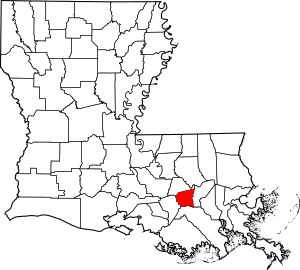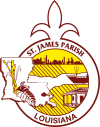St. James Parish, Louisiana facts for kids
Quick facts for kids
St. James Parish
|
||
|---|---|---|

Oak Alley Plantation Mansion.
|
||
|
||

Location within the U.S. state of Louisiana
|
||
 Louisiana's location within the U.S. |
||
| Country | ||
| State | ||
| Founded | March 31, 1807 | |
| Named for | St. James | |
| Seat | Convent | |
| Largest town | Lutcher | |
| Area | ||
| • Total | 258 sq mi (670 km2) | |
| • Land | 242 sq mi (630 km2) | |
| • Water | 16 sq mi (40 km2) 6.4% | |
| Population
(2020)
|
||
| • Total | 20,192 | |
| • Density | 78.26/sq mi (30.22/km2) | |
| Time zone | UTC−6 (Central) | |
| • Summer (DST) | UTC−5 (CDT) | |
| Congressional district | 2nd | |
St. James Parish (in French, Paroisse de Saint-Jacques) is a special area in the state of Louisiana. It is like a county in other states. The main government office, called the parish seat, is in a town called Convent.
This parish was created in 1807. St. James Parish is located between the big cities of New Orleans and Baton Rouge. It sits right along the Mississippi River. In 2020, about 20,192 people lived here.
Contents
History of St. James Parish
St. James is one of the first 19 parishes ever created in Louisiana. It was officially formed on March 31, 1807. This happened when Louisiana was still a territory, not yet a state.
The first main office was in the community of St. James. This town was on the west side of the Mississippi River. Later, in 1869, the main office moved to Convent. Convent is on the east side of the river.
Acadian Settlers Arrive
St. James Parish is part of the "Acadian Coast." The Acadians were French-speaking people. They were forced to leave their homes in Canada. The first group of Acadians arrived in New Orleans in 1764.
These 20 people, making up four families, settled along the Mississippi River. This area is now St. James Parish. Their arrival was recorded in a letter from the governor at the time.
Bonfires on the Levee Tradition
St. James Parish is famous for a fun tradition. It's called "Bonfires on the Levee." This event happens every Christmas Eve. People build very large bonfires along the river levee.
They light all the bonfires at nightfall. Local stories say that these fires help Papa Noel (like Santa Claus) see his way down the Mississippi River. This helps him deliver gifts to everyone.
Perique Tobacco: A Special Crop
St. James is the only place in the world that grows a special type of tobacco called Perique. An Acadian named Pierre Chenet, nicknamed "Perique," first brought this tobacco here.
His family has been growing it for almost 200 years. Today, it's grown on about 300 acres of land. Many large tobacco companies want this unique crop.
Geography of St. James Parish
St. James Parish covers a total area of about 258 square miles. Most of this area, about 242 square miles, is land. The rest, about 16 square miles, is water. This means about 6.4% of the parish is water.
It is one of the smallest parishes in Louisiana. It ranks fourth smallest by land area and second smallest by total area.
Major Roads and Highways
Several important roads pass through St. James Parish. These highways help people travel around the area and to other parts of Louisiana.
 Interstate 10
Interstate 10 U.S. Highway 61
U.S. Highway 61 Louisiana Highway 18
Louisiana Highway 18 Louisiana Highway 20
Louisiana Highway 20 Louisiana Highway 44
Louisiana Highway 44 Louisiana Highway 70 (This road includes the Sunshine Bridge over the Mississippi River)
Louisiana Highway 70 (This road includes the Sunshine Bridge over the Mississippi River) Louisiana Highway 3127
Louisiana Highway 3127 Louisiana Highway 3213 (This road includes the Gramercy Bridge over the Mississippi River)
Louisiana Highway 3213 (This road includes the Gramercy Bridge over the Mississippi River)
Neighboring Parishes
St. James Parish shares its borders with several other parishes.
- Ascension Parish to the north
- St. John the Baptist Parish to the east
- Lafourche Parish to the south
- Assumption Parish to the west
Communities in St. James Parish
St. James Parish has several towns and communities.
Towns
Census-Designated Places
These are areas that are like towns but are not officially incorporated as cities.
- Convent (This is where the parish government is located.)
- Grand Point
- Hester
- Lemannville
- Moonshine
- North Vacherie
- Paulina
- Romeville
- South Vacherie
- St. James
- Union
- Welcome
Other Unincorporated Community
Population and People
The population of St. James Parish has changed over the years. You can see how the number of people living here has grown and shrunk in the table below.
| Historical population | |||
|---|---|---|---|
| Census | Pop. | %± | |
| 1820 | 5,660 | — | |
| 1830 | 7,146 | 26.3% | |
| 1840 | 8,548 | 19.6% | |
| 1850 | 11,098 | 29.8% | |
| 1860 | 11,499 | 3.6% | |
| 1870 | 10,152 | −11.7% | |
| 1880 | 14,714 | 44.9% | |
| 1890 | 15,715 | 6.8% | |
| 1900 | 20,197 | 28.5% | |
| 1910 | 23,009 | 13.9% | |
| 1920 | 21,228 | −7.7% | |
| 1930 | 15,338 | −27.7% | |
| 1940 | 16,596 | 8.2% | |
| 1950 | 15,334 | −7.6% | |
| 1960 | 18,369 | 19.8% | |
| 1970 | 19,733 | 7.4% | |
| 1980 | 21,495 | 8.9% | |
| 1990 | 20,879 | −2.9% | |
| 2000 | 21,216 | 1.6% | |
| 2010 | 22,102 | 4.2% | |
| 2020 | 20,192 | −8.6% | |
| U.S. Decennial Census 1790-1960 1900-1990 1990-2000 2010-2013 |
|||
Racial and Ethnic Backgrounds
The people living in St. James Parish come from many different backgrounds. The U.S. Census keeps track of this information. The table below shows the different racial and ethnic groups living in the parish over time.
| Race / Ethnicity (NH = Non-Hispanic) | Pop 2000 | Pop 2010 | Pop 2020 | % 2000 | % 2010 | % 2020 |
|---|---|---|---|---|---|---|
| White alone (NH) | 10,538 | 10,478 | 9,917 | 49.67% | 47.41% | 49.11% |
| Black or African American alone (NH) | 10,444 | 11,145 | 9,486 | 49.23% | 50.43% | 46.98% |
| Native American or Alaska Native alone (NH) | 19 | 43 | 28 | 0.09% | 0.19% | 0.14% |
| Asian alone (NH) | 10 | 29 | 28 | 0.05% | 0.13% | 0.14% |
| Pacific Islander alone (NH) | 0 | 3 | 0 | 0.00% | 0.01% | 0.00% |
| Other race alone (NH) | 3 | 13 | 28 | 0.01% | 0.06% | 0.14% |
| Mixed race or Multiracial (NH) | 72 | 135 | 362 | 0.34% | 0.61% | 1.79% |
| Hispanic or Latino (any race) | 130 | 256 | 343 | 0.61% | 1.16% | 1.70% |
| Total | 21,216 | 22,102 | 20,192 | 100.00% | 100.00% | 100.00% |
In 2020, the parish had 20,192 people. Most residents were either non-Hispanic white or Black and African American. There were also smaller groups of Native American, Asian, and people of mixed races. About 1.7% of the population was Hispanic or Latin American.
Many people in the parish have French family backgrounds. In 2000, most people (93.78%) spoke only English at home. About 4.97% spoke French or Cajun French.
Religion in the Parish
Since the area was first settled, Christianity has been the main religion. In 2020, the Roman Catholic Church had the most followers. There were also many members of the National Baptist Convention. Other Christian groups were present too.
Economy and Industry
St. James Parish is home to several large industries. These industries play a big part in the local economy. Some of these include the Shell Convent Refinery, an Occidental Chemical Factory, American Styrenics, and Mosaic Fertilizer.
There are plans for a new large factory in the parish. The Formosa Plastic Group wants to build a big chemical plant. This plant would be built on land that includes an old plantation and graves of enslaved people. Some people are concerned about the possible increase in pollution from this new plant. They are also worried about showing respect for the historical importance of the land.
Education in St. James Parish
All public schools in St. James Parish are managed by the St. James Parish Public Schools system.
Images for kids
See also
 In Spanish: Parroquia de St. James para niños
In Spanish: Parroquia de St. James para niños



